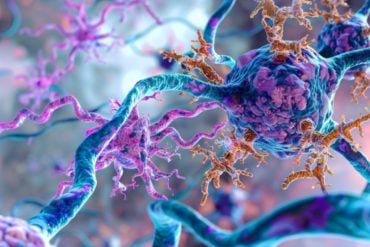Summary: People with schizophrenia who experience auditory hallucinations have greater activation in specific areas of the auditory cortex in response to sound frequencies. The mapping of sound frequency in the auditory cortex is scrambled in those with schizophrenia, suggesting a disruption in the normal processes for organized sound representation in the brain. As the tonotopic map is established during infancy and remains stable throughout life, the findings suggest vulnerability for auditory hallucinations is linked to defects in the organization of the auditory system during infantile development. This precedes speech development and the onset of psychiatric symptoms.
Source: Mount Sinai Hospital
Some people suffering from severe mental illness, particularly schizophrenia, hear “voices,” known as auditory hallucinations. This symptom, which afflicts more than 80% of patients, is among the most prevalent and distressing symptoms of schizophrenia. Patients “hear voices” speaking to them or about them without anyone actually being there. Auditory hallucinations, which usually begin in adolescence and young adulthood, “sound” very real to patients and can have a devastating impact on their quality of life because the “voices” are typically distressing and distracting, sometimes compelling the sufferer into suicidal or violent actions. Uncovering the biological origins of auditory hallucinations is essential for reducing their contribution to the disease burden of schizophrenia.
To investigate the biological origins of hearing “voices” in patients with schizophrenia, a team led by researchers at the Icahn School of Medicine at Mount Sinai used ultra-high field imaging to compare the auditory cortex of schizophrenic patients with healthy individuals. They found that schizophrenic patients who experienced auditory hallucinations had abnormal tonotopic organization of the auditory cortex. Tonotopy is the ordered representation of sound frequency in the auditory cortex, which is established in utero and infancy and which does not rely on higher-order cognitive operations. The study findings, which appears this week in the Nature Partner Journal NPJ Schizophrenia, suggest that the vulnerability to develop “voices” is probably established many years before symptoms begin.
“Since auditory hallucinations feel like real voices, we wanted to test whether patients with such experiences have abnormalities in the auditory cortex, which is the part of the brain that processes real sounds from the external environment,” says Sophia Frangou, MD, PhD, Professor of Psychiatry at the Icahn School of Medicine at Mount Sinai. ”
Specifically, the research team used an ultra-high field scanner with a powerful 7 Tesla magnet to obtain high-resolution images of brain activity while study participants listened passively to tones across a range of very low to very high frequencies. In healthy brains, these sounds are processed in a very organized fashion; each frequency activates a specific part of the auditory cortex forming a tonotopic map. The team obtained tonotopic maps from 16 patients with schizophrenia with a history of recurrent auditory hallucination and 22 healthy study participants. They found that patients showed greater activation in response to most sound frequencies. Additionally, the mapping of most sound frequencies to parts of the auditory cortex appeared “scrambled” in patients with schizophrenia, suggesting that the normal processes for the organized representation of sound in the brain are disrupted in schizophrenia.
“Because the tonotopic map is established when people are still infants and remains stable throughout life, our study findings suggest that the vulnerability to develop “voices” is linked a deviance in the organization of the auditory system that occurs during infancy and precedes speech development and the onset of psychotic symptoms by many years. This is particularly exciting because it means that it might be possible to identify potential vulnerable individuals, such as the offspring of schizophrenia patients, very early on.”

According to the authors, in addition to helping doctors spot people who are likely to experience hallucinations before the symptoms appear or become severe, the auditory cortex may be an area of consideration for novel neurmodulation methods to help patients who already have symptoms.
Looking ahead, Dr. Frangou’s research team will replicate and expand the current observations in larger samples to determine their relevance to hallucinations across diagnoses and to quantify the association of tonotopic disruption to auditory cortical activation and connectivity during actual hallucinatory experiences.
Funding: The study was supported by the National Institutes of Mental Health, the National Cancer Institute, The Netherlands Organisation for Health Research and Development, the Stanley Foundation and the Brain and Behavior Research Foundation.
Source:
Mount Sinai Hospital
Media Contacts:
Elizabeth Dowling – Mount Sinai Hospital
Image Source:
The image is in the public domain.
Original Research: Open access
“Abnormal auditory tonotopy in patients with schizophrenia”. Gaelle E. Doucet, Maxwell J. Luber, Priti Balchandani, Iris E. Sommer & Sophia Frangou.
NPJ Schizophrenia doi:10.1038/s41537-019-0084-x.
Abstract
Abnormal auditory tonotopy in patients with schizophrenia
Auditory hallucinations are among the most prevalent and most distressing symptoms of schizophrenia. Despite significant progress, it is still unclear whether auditory hallucinations arise from abnormalities in primary sensory processing or whether they represent failures of higher-order functions. To address this knowledge gap, we capitalized on the increased spatial resolution afforded by ultra-high field imaging at 7 Tesla to investigate the tonotopic organization of the auditory cortex in patients with schizophrenia with a history of recurrent hallucinations. Tonotopy is a fundamental feature of the functional organization of the auditory cortex that is established very early in development and predates the onset of symptoms by decades. Compared to healthy participants, patients showed abnormally increased activation and altered tonotopic organization of the auditory cortex during a purely perceptual task, which involved passive listening to tones across a range of frequencies (88–8000 Hz). These findings suggest that the predisposition to auditory hallucinations is likely to be predicated on abnormalities in the functional organization of the auditory cortex and which may serve as a biomarker for the early identification of vulnerable individuals.






